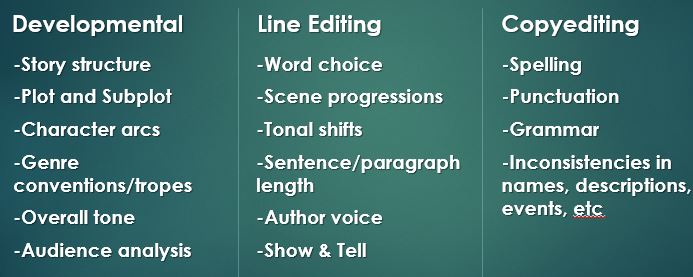So, you’ve just finished writing your manuscript and you’ve decided to hire an editor to look it over. Simple enough, right?
But do you know what type of edit you need? Were you aware that there was more than one kind? If you did, you’re ahead of the curve. If not, read on.
In answer to the titular question, yes there is more than one type of edit. There are three types of edits and then the final review, but to make all our lives simpler, remember the number 4.
What The Four Types Are
The four stages of the editorial process are:
- Developmental Editing
- Line Editing
- Copyediting
- Proofreading
Developmental Editing involves a big picture review of your manuscript. Does your story have a clear beginning, middle, and end? Does it follow the tenants of its genre? What’s the book’s tone? Does it align with the genre and subgenre(s) you’ve chosen? Does your protagonist/antagonist have a character arc? This edit involves Track Changes comments throughout the document and a separate summary/report that lays out the answers to these questions and poses some to the author as well.
Line Editing begins what I refer to as paragraph level edits. This involves reviewing a manuscript with an eye for how the bricks fit together instead of how the entire structure looks. I look at diction, individual scene cohesion, tonal shifts, author voice, minor characters and their arcs. This is also where the discussion of Show & Tell begins. You read right. A good manuscript has a mix of both, no matter what the popular belief is. Comments are left throughout the manuscript. Recurring issues are addressed as well; a great editor should note mistakes or foibles that appear throughout your writing to help you improve.
Copyediting is where the majority of the spelling, grammar, punctuation, and sentence level checks are performed. Does that comma belong there? Is that the correct spelling of Scheherazade? Are all of your sentences complete? Are the ones that aren’t purposefully so? The copyedit is also where the consistency check is done. Is your MCs name spelled the name throughout? Does the capital of the magically hidden continent have one l or two? Comments and Track Changes suggestions are left throughout the manuscript.

Proofreading is the final chance for you to ensure that your work is as error-free a possible before publication. Reviewing a PDF file during this process is standard. Proofreaders are checking to ensure that all of the grammar, punctuation, and spelling is correct one final time. There shouldn’t be any comments at this stage.
Where Each Type Fits in the Publishing Process
Now that you’ve learned about the four editorial stages and what each entails, it’s time to talk about where they fit in the greater scheme of things. Your goal as a writer is to publish your work. On your website. On Amazon. With a publishing house. Wherever. So, when you think about edits and editors, you have to place them within that greater publishing framework.
Since I work with indie authors, I will be discussing the editorial process as it relates to the Self-Publishing Process. If you’re seeking to self-edit or querying agents for a traditional publishing deal, this content can still offer you insight into those processes even though it does not directly relate.
The graphic below lays out three versions of the self-publishing process, detailing the steps taken from first draft to final publication. Take a look with a particular eye for where each of the editing stages is listed.

Final Thoughts
There are many paths to publishing, but one thing that I hope you’ll take away from this post is the value an editor provides. Your goal is to publish a story your readers will love. Your editors job is to help you do that.
Hopefully, this post has cleared up any confusion you had about the editing process. If you have any more questions, or you’d like to work with me, head over to the Contact page and we can talk shop.
________________________________________________________________________________
Note: Not all freelance editors offer every service and, although there are industry standards, not all editors define the types of edits in the same manner. When looking for an editor to work on your manuscript, gather as much information as possible about the edits they offer and the scope of work.